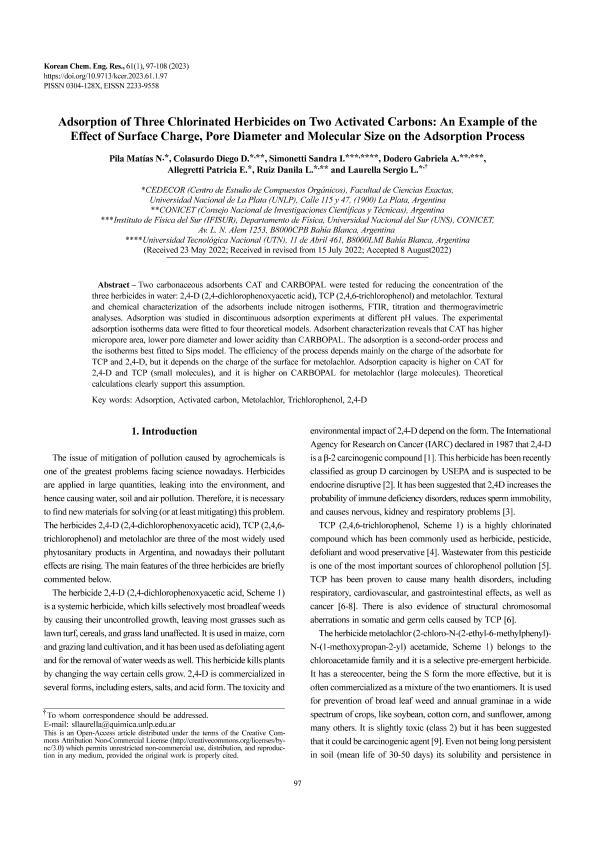Artículo
Adsorption of three chlorinated herbicides on two activated carbons: an example of the effect of surface charge, pore diameter and molecular size on the adsorption process
Pila, Matías Nicolás ; Colasurdo, Diego Damián
; Colasurdo, Diego Damián ; Simonetti, Sandra Isabel
; Simonetti, Sandra Isabel ; Dodero, Gabriela Alejandra
; Dodero, Gabriela Alejandra ; Allegretti, Patricia Ercilia; Ruiz, Danila Luján
; Allegretti, Patricia Ercilia; Ruiz, Danila Luján ; Laurella, Sergio Luis
; Laurella, Sergio Luis
 ; Colasurdo, Diego Damián
; Colasurdo, Diego Damián ; Simonetti, Sandra Isabel
; Simonetti, Sandra Isabel ; Dodero, Gabriela Alejandra
; Dodero, Gabriela Alejandra ; Allegretti, Patricia Ercilia; Ruiz, Danila Luján
; Allegretti, Patricia Ercilia; Ruiz, Danila Luján ; Laurella, Sergio Luis
; Laurella, Sergio Luis
Fecha de publicación:
02/2023
Editorial:
Korean Institute of Chemical Engineers
Revista:
Korean Chemical Engineering Research
ISSN:
0304-128X
e-ISSN:
2233-9558
Idioma:
Inglés
Tipo de recurso:
Artículo publicado
Clasificación temática:
Resumen
Two carbonaceous adsorbents CAT and CARBOPAL were tested for reducing the concentration of the three herbicides in water: 2,4-D (2,4-dichlorophenoxyacetic acid), TCP (2,4,6-trichlorophenol) and metolachlor. Textural and chemical characterization of the adsorbents include nitrogen isotherms, FTIR, titration and thermogravimetric analyses. Adsorption was studied in discontinuous adsorption experiments at different pH values. The experimental adsorption isotherms data were fitted to four theoretical models. Adsorbent characterization reveals that CAT has higher micropore area, lower pore diameter and lower acidity than CARBOPAL. The adsorption is a second-order process and the isotherms best fitted to Sips model. The efficiency of the process depends mainly on the charge of the adsorbate for TCP and 2,4-D, but it depends on the charge of the surface for metolachlor. Adsorption capacity is higher on CAT for 2,4-D and TCP (small molecules), and it is higher on CARBOPAL for metolachlor (large molecules). Theoretical calculations clearly support this assumption.
Palabras clave:
2
,
4-D
,
ACTIVATED CARBON
,
ADSORPTION
,
METOLACHLOR
,
TRICHLOROPHENOL
Archivos asociados
Licencia
Identificadores
Colecciones
Articulos(CCT - LA PLATA)
Articulos de CTRO.CIENTIFICO TECNOL.CONICET - LA PLATA
Articulos de CTRO.CIENTIFICO TECNOL.CONICET - LA PLATA
Citación
Pila, Matías Nicolás; Colasurdo, Diego Damián; Simonetti, Sandra Isabel; Dodero, Gabriela Alejandra; Allegretti, Patricia Ercilia; et al.; Adsorption of three chlorinated herbicides on two activated carbons: an example of the effect of surface charge, pore diameter and molecular size on the adsorption process; Korean Institute of Chemical Engineers; Korean Chemical Engineering Research; 61; 1; 2-2023; 97-108
Compartir
Altmétricas



